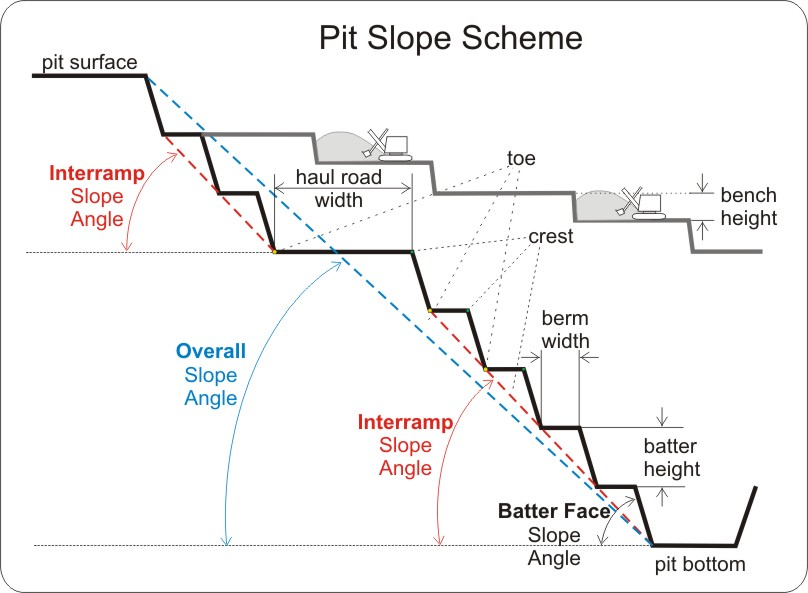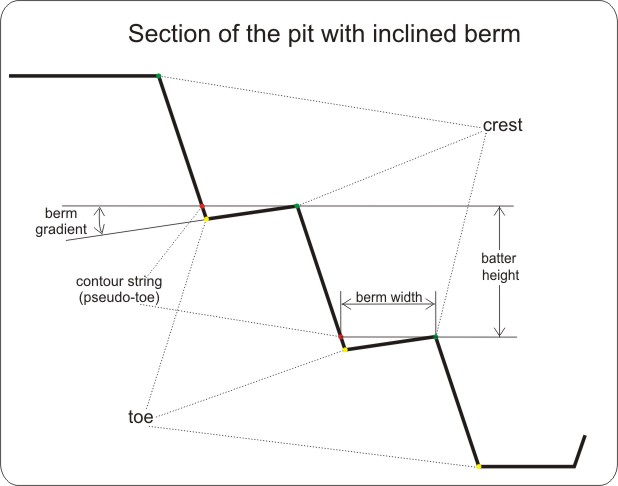Modify Parameters
When a Pit Design layer is the active layer, Elevation, Berm Gradient, Direction, Batter Height, Batter Slope and Berm Width parameters are shown on the Mining | Pit Design tab, in the Modify Parameters group, where they can be easily viewed and edited:

These parameters are used by the design tools elsewhere on the ribbon, for example, the Project to Elevation. Project to Berm and Expand String tools on the Mining | Pit Design tab, in the Generate Pit Contours group.
Terminology

Interramp angle
The Interramp angle is the slope angle produced by a number of benches. (It is assumed that the Batter Slope, Batter Height and Berm Width are constant).
The overall slope angle, on the other hand, is the angle of a line from the toe at the bottom of the pit, to the crest of the pit surface. Since this slope takes into account the haul roads and all working levels, it will not be constant at all parts of the pit.
It therefore follows that the Interramp angle will be steeper than the overall slope angle, and this must be taken into consideration during the pit design.
Batter height
After the initial cut the Bench will present a face, and at this stage a bench can also be called a Batter.
Batter height is the vertical distance between Toe and Crest of the bench or the vertical distance between the upper surface of the bench and the lower (floor) surface of the bench. It is the Batters that form the final pit limits.
A "bench', on the other hand, is an operational open-pit concept. Pits are mined by benches, this is the unit of reference for extraction. A bench has an upper and lower surface. It can be described as a tabular body with a specific thickness called Bench Height. When benches achieve the final pit limit they form a pit 'batter'.
Batter slope
The Batter slope is the default angle, measured from the horizontal, between successive toe and crest strings. The angle is measured in degrees to 2 decimal places and the angle value should be greater than 0 and less than 90.
Berm width
The Berm width is the horizontal distance between a toe and a corresponding crest at the same level.
Berm Width is used to define the required width between bench faces. It is the measurement from the toe of the upper bench to the Crest of the lower Bench. Berms are necessary to provide slope stability and other safety reasons.
Contour interval
A Contour interval value is used to generate additional contour strings between successive toes and crests, for example, to denote benches. You can use the Contour interval to design sub-benches with a different road width. The Batter height must be a multiple of the Contour interval value.
Ramp Gradient Unit
The ramp gradient unit is the unit of measurement for the gradients of elements such as roads, ramps, switchbacks in your design. Use the drop down list to select the default Ramp Gradient unit:

Berm Inclination
Sometimes a slope may need to be designed into the berms in order to collect water or stone fragments against the pit wall. If this is the case, select the Berm Inclination option and enter a Backslope Gradient value. The value you enter should fall between 0 and 10 (typically 5 or 10) %.
When a Berm gradient value is specified, an additional contour string is shown in the design, alongside the crest, toe, and road strings. This contour string represents a "pseudo" toe, in other words, it denotes where the toe would be without the berm gradient. ![]() Show me...
Show me...
